Click on images to enlarge
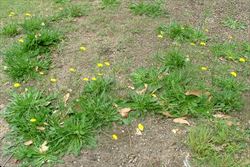
invading a bare area (Photo: Sheldon Navie)
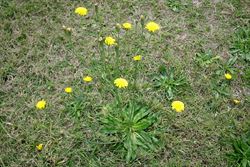
habit (Photo: Sheldon Navie)
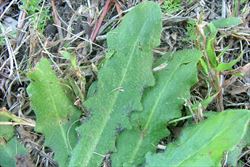
close-up of rosette leaves (Photo: Sheldon Navie)
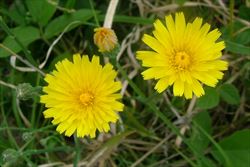
flower-heads (Photo: Sheldon Navie)
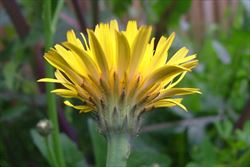
close-up of flower-head from side-on (Photo: Sheldon Navie)
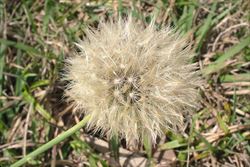
mature fruit (Photo: Sheldon Navie)
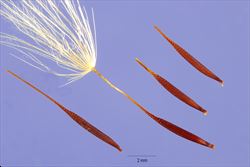
close-up of seeds (Photo: Steve Hurst at USDA PLANTS Database)
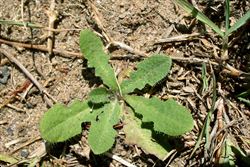
young plant (Photo: Sheldon Navie)
Scientific Name
Hypochaeris radicata L.
Synonyms
Hypochoeris radicata L.
Family
Asteraceae (Queensland, New South Wales, the ACT, Victoria, Tasmania, Western Australia and the Northern Territory)Compositae (South Australia)
Common Names
cat's ear, cat's ear dandelion, cat's-ear, catsear, common catsear, false dandelion, flat weed, flatweed, hairy cat's ear, hairy cat's-ear, hairy catsear, hairy wild lettuce, rough cat's ear, spotted cat's ear, spotted cat's-ear
Origin
Native to northern Africa (i.e. Algeria, Libya, Morocco and Tunisia), most of Europe (i.e. Denmark, Ireland, the UK, Norway, Sweden, Austria, Belgium, Czechoslovakia, Germany, Hungary, the Netherlands, Poland, Switzerland, Belarus, Moldova, Ukraine, western Russia, Albania, Bulgaria, Greece, Italy, Romania, Yugoslavia, France, Portugal and Spain) and western Asia (i.e. Turkey, Azerbaijan, Georgia and southern Russia).
Naturalised Distribution
This species is widely naturalised and common in large parts of southern and eastern Australia. It is widespread and common in south-eastern Queensland, New South Wales, the ACT, Victoria and south-eastern South Australia. Less common or occasionally naturalised in the coastal districts of central and northern Queensland, in Tasmania, in south-western Western Australia, and in the southern parts of the Northern Territory.
Also naturalised on Lord Howe Island and Norfolk Island, and naturalised overseas in southern Africa, New Zealand, Hawaii, the USA, Canada, Central America and South America.
Notes
Flatweed (Hypochaeris radicata) is regarded as an environmental weed in New South Wales and Victoria. It is a very common weed of parks, gardens, footpaths, lawns, roadsides, disturbed sites, waste areas, cultivation and pastures in south-eastern Australia, but is also common in natural habitats.
This species is possibly the most widely distributed weed in south-eastern Australia. It is particularly aggressive in disturbed habitats, although it even invades relatively undisturbed forests. Other habitats invaded include grasslands, remnant grassy woodlands, open woodlands and wetland margins. It can become dominant where there is regular soil disturbance and, because it produces rosettes, individual plants can cover a relatively large area of soil. This allows this species to suppress native grasses and herbs quite effectively.
Flatweed (Hypochaeris radicata) has been recorded in numerous conservation areas in Victoria (e.g. Brisbane Ranges National Park, Phillip Island Nature Park and Wilsons Promontory National Park), South Australia (e.g. Marino Conservation Park, Brownhill Creek Recreation Park, Hale Conservation Park, Totness Recreation Park, Cudlee Creek Conservation Park and Eurilla Conservation Park) and New South Wales (e.g. Rawdon Creek Nature Reserve and Kosciuszko National Park). It also appears on local and regional environmental weed lists in Victoria (e.g. Manningham, Knox City and the Goulburn Broken Catchment) and New South Wales (e.g. in the wider Sydney and Blue Mountains region and on the Central Coast).
It is reported to grow in the ground layer of several endangered ecological communities in New South Wales and the ACT (e.g. bangalay sand forests, sub-tropical coastal floodplain forests and natural temperate grasslands), and may be a threat to the integrity of some of these communities. In Wilsons Promontory National Park, in southern Victoria, flatweed (Hypochaeris radicata) grows in habitats occupied by the endangered late helmet-orchid (Corysanthes sp. aff diemenicus). It may threaten the survival of this species at this site, which is one of only two locations where this rare native plant is known to exist in the wild.

